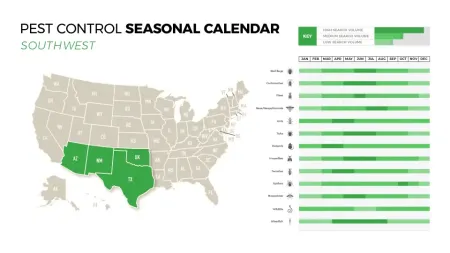Seasonality in Business: The Science Behind Seasonal Budgets

Seasonality refers to any predictable fluctuation or pattern that recurs or repeats over a certain time period. You can find seasonality in almost every business, and the fact of the matter is that ebbs and flows are just a natural part of running a small business. The pest control industry experiences seasonality more often than other industries due to the nature of pests. As a business owner, you have probably seen your consumer’s purchasing habits shift based on the activity of different pests throughout the year. Because each season comes with specific pest behaviors and unique needs for pest control services, this causes consumers to behave differently, thus providing opportunities for your business to thrive.
Seasonality doesn’t stop with sales; in fact, it starts with marketing.
Seasonal marketing is about looking at the calendar, identifying shifts in buyer behavior based on your industry, and capitalizing on these opportunities. The goal of seasonal marketing in the pest control industry is to target important needs at certain times in order to drive attention to your service with the intention of boosting your business revenue. However, as the old saying goes, “you can’t make money unless you spend money."
How often do you think about seasonality when setting a budget for the year? Do you wonder if what you have budgeted will be enough for you to reach your growth goals?
Below are some tips on what you should consider when planning your seasonal marketing budget for the year:
1. Lead Tracking:
Seasonal marketing starts with tracking your leads. Tracking leads will give you an idea of what times customers have searched for, purchased, and even cancelled your services most in the past, so that you can start to evaluate how your budget might be allocated across the year.
Analyzing your search seasonality will provide you with valuable knowledge about when it’s profitable to target specific buying behaviors and how to move forward when creating your budget. Without tracking your peak seasons, you have no way to know what times of the year are best to apply your seasonal marketing budget. Not tracking leads can lead to wasting precious money on ineffective marketing.
Tracking leads is CRITICAL to measuring success and helping adjust your budget to maximize marketing potential. At Coalmarch, we use lead tracking to forecast buying behavior and seasonality for the year. These include:
• Cost-per-click in specific markets
• Cost-per-lead goals
• Growth goals
• Past performance
We cannot emphasize enough how important lead tracking is. That’s why we created a FREE eBook, “The Complete Guide to Tracking Leads” to help you. Check it out before moving onto the next tip.
2. Keywords:
Have you ever thought about seasonal demand by keyword? Even with seasonal budgets, you can segment your spending even more into specific campaigns.
By knowing certain keywords, you can accurately track seasonality for your region and business. For example, mosquitoes are prominent almost everywhere in June; therefore, in this month, you’re going to want to spend more of your budget promoting your mosquito control services.
Similarly, in the winter, you can expect to spend more of your budget on rodents. Bedbug demand typically aligns with travel-heavy seasons.
By knowing what your customers are searching for beforehand, you can get ahead of the game and be that much more prepared to meet their needs and make that sale.
3. Forecasting:
From an internal standpoint, having the right information from tracking leads will help you now visualize trends, make predictions, and take action in a way that is easy to comprehend and apply. Your company’s past data can help inform future decisions and help you track and analyze the seasonal peaks and valleys of your business within a fiscal year.
Another way you can figure out your business’ seasonality is by looking at its website traffic performance. Web traffic seasonality refers to the predictable, yearly upward and downward trends in the search results that continually fluctuate in annual patterns. By looking at your website's traffic performance, you can easily detect seasonal spikes. For full access to our industry-specific, seasonal marketing data, be sure to download our FREE Annual Marketing Benchmark Report.
From an external standpoint, look at the industry to tell you where seasonal trends occur. Depending on the region in which you conduct business, most pest behavior is similar and can be predicted each year. Not sure where to start? Take a look at our seasonal calendar for the Southwest below.

4. Plan during Off-Season:
So you’ve figured out your peak seasons. Great. What next? No matter when your peak season falls, a profitable business is prepared for the off-season too. Any business owner aims to produce an increase in sales when they normally lag in the off-season. But how do you do this? Seasonal budgeting means making adjustments to compensate for those times when business is booming, which means adjusting and using your budget wisely before sales start to climb. It is during your downtime that you should spend your marketing budget on developing new marketing strategies for the peak seasons.
Make allowances for what you’ll need to get your business ready for the peak season and plan for what you’ll be spending more on in the coming months. Use this list to start thinking about the different expenses that the peak season will require out of your budget:
• Hiring and training new technicians
• Launching new marketing campaigns
• Stocking up on inventory for trucks
• Replacing and repairing any equipment
5. Peak Season Performance:
Peak season is characterized by high purchasing rates because it is in these times that your consumers are looking to buy. For the pest control industry, generally, demand is highest in spring and summer months because pest activity is highest in those seasons. As a business, you should be allocating more money in your budget to spend during the peak season because expenses will accrue. Although you are spending more during this time, you are getting the most cost-effective leads from paid channels too.
As Laura Simis, Coalmarch Communications Manager, states, “Before the peak season, we factor in our client’s revenue goals, recurring revenue and attrition of current customers, and sales closing rate to predict how many new customers they need to convert in the year in order to be profitable. We also use conversion rate, historical performance, and cost-per-click models to predict the most beneficial allocation of the PPC budget across high-volume months.”
What next?
Seasonal marketing is all about having excellent timing, unique content, and a perfect campaign execution that earns engagement. When you are in the peak season of business, follow these short tips for a successful seasonal marketing campaign.
• Set measurable goals for the campaign
• Nail down the message and approach
• Revisit your budget and fine-tune it
• Market your campaign to each customer individually, not just as a whole
• Review and repurpose your campaign




